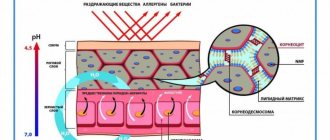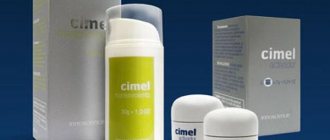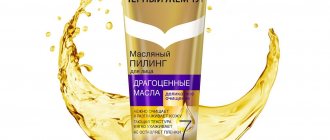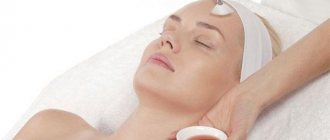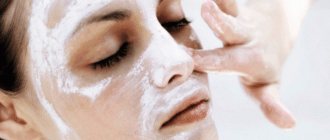After undergoing a facial cleansing procedure in a salon, many women wonder: is it possible to do a chemical facial peel at home? The answer is yes, but there are several nuances.
It is unlikely that you will be able to carry out deep facial cleansing on your own. And the point is not at all in the absence of drugs for such a procedure - they can be found. Safety and absence of complications are the main aspect.
Cosmetologists also do not recommend doing medium peeling at home to avoid unpleasant consequences. After all, quite aggressive chemicals are used for these purposes, the body’s reaction to which can be unpredictable.
But superficial cleansing with all kinds of drugs and home remedies is even welcome.
Let's delve into the essence of the issue.
What to use for a chemical peel at home
Before you start choosing a peeling drug at home, you need to conduct an “internal investigation” - let's call it this way:
- highlight the problems that you want to get rid of through the procedure;
- choose the appropriate type of peeling;
- conduct pre-peel preparation and stock up on knowledge about post-peel care.
Now we smoothly move on to the types of self-peeling. All the means used can be divided into four groups:
- natural products that are available at home or can be purchased in the store. We choose those that have a peeling effect and based on them we create our own composition (recipes for the most effective ones are attached);
- professional products that are used to perform procedures in salons. They can be purchased in specialized stores. Professional peeling at home is an excellent alternative to salon care. But carefully read the composition of the product, not only the effect, but also your safety depends on it;
- pharmaceutical products that have a peeling effect. There are medications in pharmacies that can not only cleanse the epidermis, but also have a therapeutic effect on “damaged” skin;
- products from stores selling components for soap making and cosmetics.
When considering peeling with pharmaceutical products, you should pay special attention to finished products. This is the optimal, safest option, since the composition is balanced and the risk of side effects is almost zero. For example, among enzyme peelings, “Enzyme-salicylic peeling Stopproblem” is very popular. It is perfect for young skin, cleanses and prepares the epidermis before applying nourishing masks or creams.
Acid chemical peels are more complex and more aggressive. However, such compositions are capable of combating a large number of problems and can be used at any age.
There are ready-made products with these active ingredients. Very often, acids are included in professional scrubs used for home peeling. However, you can purchase a separate acid at a pharmacy or specialty store and create a product for yourself.
The most commonly used acid components are:
- salicylic;
- glycolic;
- dairy;
- retinol;
- apple;
- pro-grape;
- lemon;
- almond and others.
Home chemical peeling is an effective facial cleansing procedure that should be performed regularly. This approach will significantly save time and money. However, you need to be absolutely sure that the manipulation will not harm.
What's happened
Deep peeling is a cosmetic manipulation during which the skin is intentionally injured. As a rule, the same thing is noted that can be observed when wounds and scratches heal. In other words, the natural regeneration process is launched.
To achieve this result, with the help of special devices and acidic substances, layer-by-layer destruction of the layers of the skin occurs, as a result of which the cellular structures begin to peel off.
Kinds
Experts identify several types of deep cleansing, each of which has its own characteristics and principle of action.
Laser
In order for the cells to begin to recover faster and produce collagen, the layers of the skin are exposed to a laser beam. This leads to the destruction of dead cellular structures and the elimination of minor defects. Infection with this method is minimal, since the rays simultaneously have a disinfecting effect.
Ultrasonic
It is considered a more gentle and painless technique. In addition, it does not have many restrictions on its use. It does not require a long recovery period due to the fact that tissue trauma is minimal. However, it is worth noting that the effect will be less pronounced compared to other methods.
Radio wave
In some ways, this technique has some similarities with the laser procedure. But in this case, the recovery period is somewhat shorter.
The pain syndrome disappears after three to four days. To see the final result, you will need to wait 7 days. This technique has a cumulative effect, which is expressed in its severity every month.
Acid
This is a type of deep chemical peel. Refers to less traumatic. As a rule, acids such as citric, glycolic, lactic, tartaric, acetic and others are used during work.
In order to affect the layers of the dermis as deeply as possible, ultrasound or a laser beam is used.
The main effect of this manipulation is considered to be skin rejuvenation.
Phenolic
Types of deep chemical peeling include cleansing with phenolic acid. This technique poses the greatest threat to health and has the most profound effect on all layers of the skin.
On this topic
- Peeling
Peeling PRX-T33
- Olga Aleksandrovna Kalinina
- October 21, 2020
This substance has a controversial reputation. The advantage is that after using it, the skin becomes much younger.
The disadvantage of this technique is its toxicity. It is for this reason that before deciding to use this type of cleansing, a diagnostic examination of the liver, kidneys and excretory systems is required.
Are there any contraindications and side effects?
Before you do a chemical facial peel at home, make sure that your skin will respond normally to such exposure. The method is quite aggressive and has its contraindications and warnings.
Peeling should not be carried out in the following cases:
- allergy to the components of the product;
- damage to the integrity of the skin (wounds, scratches, cracks), as well as in the presence of purulent pimples, exacerbation of acne;
- exacerbation of herpes infection;
- neoplasms on the face, regardless of origin;
- inflammatory processes at the site of exposure;
- mental disorders;
- exacerbation of chronic ailments;
- situational diseases in acute form, accompanied by an increase in body temperature;
- pregnancy at any stage;
- breastfeeding period;
- age up to 18 years. Only for special indications and in the salon!!!
The chemical peeling procedure is also not recommended during menstruation and while taking hormonal medications (including contraceptives). During this period, the body's reaction is unpredictable.
Side effects include the following:
- skin redness;
- dryness and flaking;
- the appearance of swelling.
These manifestations may be present for a short period of time (from several hours to 2-3 days). With proper care, they disappear spontaneously and do not require specific intervention.
If after the session you notice severe hyperemia, swelling, or a burning sensation that gets worse, you need to seek qualified help from a cosmetologist or dermatologist.
It should also be noted that if contraindications are taken into account, all rules of preparation, execution of the procedure, and post-treatment are observed, negative consequences do not develop.
Peeling for the intimate area: recipes, rules of procedure, indications and contraindications
Indications for intimate area peeling:
- Pigmentation;
- Peeling;
- Stretch marks and scars;
- Flabbiness, wrinkles;
- Mild irritation.
Contraindications for intimate peeling:
- Pregnancy and lactation period;
- Inflammatory processes and open wounds;
- Exacerbation of herpes;
- Individual intolerance;
- Skin hypersensitivity;
- Infectious skin diseases.
Glycolic intimate peeling
This type of acid is most often used for whitening, eliminating ingrown hairs and rejuvenating the bikini area:
- We clean the dermis with a degreasing lotion;
- Apply a solution of weak concentration, wait 20 minutes;
- Remove with neutralizer, rinse with water and apply moisturizer.
Laser peeling in an intimate area
Laser cleaning is usually done only in salons, but if you have the device at home, then using it to remove stains, scars, scars and wrinkles is very easy;
- We configure the device to the required power;
- We move the nozzle with a laser beam at a distance of 5 cm from the skin for 7 minutes, do not stay in one place for a long time;
- Apply nourishing cream.
Intimate peeling after shaving
To prevent the skin from being irritated after hair removal, this natural composition is prepared:
- Pour in a small amount of milk 1 tbsp. l. oatmeal, leave for 10 minutes;
- Mix and use in the bikini area.
Intimate sugar peeling
To maintain moisture levels and soften the skin, use the following:
- Dilute a large spoonful of sugar with olive oil;
- Mix until the consistency is homogeneous.
Chemical intimate peeling
This type of cleansing involves the use of the following acids, following the example of glycolic acid:
- Milk: moisturizes and exfoliates;
- Almond: eliminates problematic rashes;
- Wine: brightens;
- Lemon: whitens and cleanses.
Intimate peeling with aspirin
To treat irritated areas after shaving, it is recommended to use this method:
- Dilute 2-3 tablets of acetylsalicylic acid with boiled water;
- Rub it gently over the skin, hold for 3 minutes;
- Wash off and wipe with 3% hydrogen peroxide.
Intimate whitening peeling
To lighten age spots, scars and scars, you can try this mixture if your skin is not irritated:
- Combine a large spoon of hydrogen peroxide with half a teaspoon of ammonia;
- We treat problem areas;
- After 5 minutes, wash off and use twice a week, avoiding contact with mucous membranes.
We also recommend that you read the article Peeling the bikini area at home.
To contents
How to do a chemical peel at home
Before studying the specifics of the procedure, let us discuss an important point. If this is your first time using the active composition, you must conduct a sensitivity test. To do this, apply a drop of the prepared mixture to the inside of the elbow or to a small area behind the ear. If after a quarter of an hour no discomfort is observed, the procedure can be carried out.
Let's look at how to do chemical peeling for the face at home step by step. But first, let’s say that 2-3 weeks before the procedure it is necessary to limit exposure to the sun and apply a special cream at night that will prepare the skin for the effects of the active composition.
Now directly step-by-step instructions on how to do chemical peeling at home:
- cleanse the skin of makeup and surface impurities. To do this, use gel or milk for washing;
- skin preparation. Vaporization is carried out in the salon using a special apparatus. You can prepare your face at home in this way - apply a very warm compress from a decoction of medicinal herbs for 2-3 minutes;
- treatment with active composition. You can apply the prepared product with a brush or cotton pad. Distribute evenly over the entire surface, avoiding the area around the eyes and lips;
- The duration of the procedure is no more than five minutes. Some formulations may have less. During exposure, a slight tingling or burning sensation may occur - this is normal. If the sensation is too strong, immediately rinse off the product with water. To avoid side effects, you must immediately apply a soothing cold compress from a decoction of the string to your face;
- After the specified time, the composition is washed off with a large amount of first warm and then cold water. Cosmetologists recommend stocking up on a product to restore skin pH and applying it to your face immediately after removing the working composition;
- After five to ten minutes, apply a moisturizing or nourishing cream according to your skin type.
Helpful advice. It is better to carry out the procedure in the evening. And it is advisable before the weekend for the face to fully recover. Before going outside, use sunscreen with a high level of UV protection.
Stages of the procedure
The deep facial peeling procedure consists of several stages:
- A cosmetologist assesses the client's skin condition, identifying problems.
- The face is completely cleansed of makeup and dirt. The skin is treated with a degreasing lotion.
- A previously selected peeling substance is applied to the skin. The cosmetologist sets the exposure time depending on the aggressiveness of the substances and their effect on the epidermis.
- After time, the substance is removed with a neutralizer. A soothing cream is applied to the skin.
- If the procedure was carried out with phenol, a chemical film of jelly is applied to the skin, which after deep peeling must be kept on the face for up to three days under the supervision of specialists. Afterwards, the skin is treated for wounds and damage.
We recommend: Biorevitalization and peeling. Is it possible to do one after the other and after what time?
The duration of the session depends on the area of skin being treated. It usually takes from 20–30 minutes to an hour.
Home Recipes
As agreed before, we provide recipes for chemical peeling of the face at home. Home remedies include ingredients that are either always on hand or can be easily purchased at a store, pharmacy, or market.
- "Fruit Paradise" Preparing the peeling composition is very simple. You need to use fruits with a high acid content: apricots, citrus fruits, kiwi, gooseberries, cherries, raspberries, currants, cranberries, lingonberries, strawberries. To make the procedure more effective, you can make a potion from several components. Just grind the selected ingredients into a paste and carry out the manipulation according to the above plan.
- Yogurt-lemon. This self-prepared chemical peeling will not only cleanse the skin of dead skin particles, but will also help cope with age spots. You need to take an equal amount of unsweetened fresh yogurt, lemon juice and cane sugar. Further everything is according to the standard.
- Calcium chloride. Do-it-yourself chemical peeling from a pharmaceutical preparation will have an amazing effect. The skin will become soft, smooth, tightened, fresh. But keep in mind that this is a mid-cleaning and you need to act very carefully. Apply the solution from the ampoule to the skin in several layers, and then use baby soap to roll it off along with dirt and other unnecessary particles.
- "Emergency help". You won’t be able to get a solution of salicylic acid in a pharmacy—it’s extremely difficult to find it in its pure form. But salicylic alcohol is commercially available. With its help you can get rid of acne, pimples, blackheads. But this is a slow and painstaking task. It is necessary to apply alcohol to problem areas using a cotton swab.
- Honey, lemon. Among cleansing compositions, honey-based products are especially popular. The bee product has bactericidal, nutritional and moisturizing properties. The simplest recipe is to mix equal amounts of honey and lemon juice. Apply the composition to a previously prepared face and leave for a quarter of an hour. Then rinse with water and apply moisturizer according to your skin type.
As you can see, there are many alternative natural remedies that are no less effective than professional ones. However, if there are serious problems, the help of a specialist is irreplaceable.
Advantages and disadvantages
Among the main advantages of deep peeling, cosmetologists highlight the ability to get rid of wrinkles, tighten the shape of the face, and correct visible defects.
On this topic
- Peeling
What are the benefits of body peeling?
- Inna Viktorovna Zhikhoreva
- June 13, 2020
Disadvantages include the presence of pain, a high risk of complications, a long recovery period, and mandatory protection of the treated skin from exposure to ultraviolet radiation for several months.
Deep peeling is the most effective method for eliminating facial skin imperfections. If the procedure is carried out correctly, then after a certain time you will see amazing results.
The skin is rejuvenated, its texture and tone are smoothed, the look becomes fresh and healthy. However, it is important not to forget that such manipulation has many contraindications and may be accompanied by side effects. To prevent this, the choice of clinic and specialist must be approached with special attention.
How to care for your face after procedures
There is a certain “set of rules” that ensure the effectiveness of any cleansing procedure (salon or home). Failure to comply may result in negative consequences - remember this!
So:
- do not touch your face unless absolutely necessary - the skin is very thin and sensitive after the procedure, injury or infection is possible;
- for the first three days, do not wash yourself with a running rein, use a cooled, boiled one for these purposes;
- do not exfoliate the skin forcibly, so as not to injure the surface of the face;
- regularly apply a moisturizer according to your skin type;
- Before going outside, use sunscreen with a high UV protection factor;
- do not visit baths, saunas, or swimming pools for a week;
- month – taboo on solarium, beach.
Chemical peeling of the face at home is a procedure that should be performed regularly. But give preference to the autumn-winter period, when the sun is not so active.
Recommendations from cosmetologists
Chemical peeling for the face at home according to individually selected recipes is a great opportunity to keep yourself in shape all the time. Cosmetologists not only do not object, they even strongly recommend doing such procedures yourself.
The opinion of experts is as follows:
- a safe alternative to chemical peeling carried out in the salon - a jointly selected product, procedures, compliance with precautions and post-care rules. A cosmetologist will help you take all these aspects into account;
- be sure to take into account your skin type in order to choose the right active ingredients and the regularity of “home cosmetology” sessions;
- If you detect any incomprehensible manifestations that cause even the slightest discomfort, seek professional help.
Manipulations must be carried out extremely carefully, do not use highly concentrated products, and take into account the characteristics of your own body. Only then can good results be achieved.






